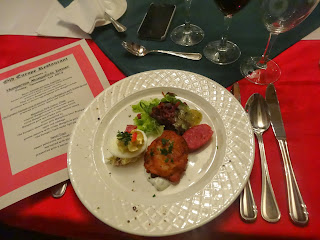The Hungarian National Association of Mangalica Breeders recently came to town in their efforts to increase their export business, and they, along with the Embassy of Hungary, invited us to a discussion and tasting of the Hungarian Mangalica pig.
The Mangalica pig, which can sometimes be mistaken for sheep at first glance due to their abundance of curly hair, was born out of a 19th-century Austro-Hungarian experiment in cross breeding with a wild boar and a pig bred especially for lard. The deep red Mangalica meat is almost beef like in appearance. A pig that looks like a sheep on the outside and a cow on the inside? The Mangalica is truly one of a kind. Beyond looks, the Mangalica is most known for it's 50-percent fat content. Rich in unsaturated fat, it's one of the fattiest, but tastiest pigs around, as it has a coveted marble and buttery flavor. Because of it's high fat content, utilization is key, and the Hungarians really know how to use every part of the Mangalica in a dish. The pig is often cooked in its own fat, drippings are used to flavor breads, and many dishes stuff meat with other cuts of meat.
With the help of Old Europe Restaurant, who crafted a four course dinner to highlight the Hungarian Mangalica, we were able to discover just why the Mangalica has its own festival dedicated to it.
How do you begin a dinner that features four courses of Mangalica pig? With charcuterie made from the Mangalica, of course. One of the specialty meats on display was the super rich and indulgent salami from Pick, the largest Mangalica meat producing business in the world.
Each of the guests were graciously gifted with a Mangalica pin.
To begin our meal, we were served our choice of red or white wine. I chose the 2011 Eszterbauer Kadarka Nagyapám, which was both fruity and spicy.
The Bacon, Sausage, and Ham appetizer was a wealthy display of the Mangalica pig in and of itself, but this was just the beginning of a full night showcasing the Mangalica.
Literally every bite of food incorporated the Mangalica pig. Garden greens were served with a potato Mangalica bacon dressing, and even the deviled eggs were garnished with Mangalica ham.
Old Europe's Goulash soup, prepared with onions, apples, and fresh herbs, was served with an endless supply of bread and spread.
The spread was made with none other than Mangalica pork. I typically don't add butter to my bread when dining out, but the crispy bits of Mangalica pork in this spread had me reaching for more bread to spread this treat across.
After our appetizers and soup and pork spread, it was time for the Mangalica Pork to take center stage (not that it hadn't been the center of attention already). For the main course, Mangalica was prepared three different ways, but we didn't have to choose which type of pork we wanted most, as we were served all three. All guests were served roasted Mangalica pork with a beer gravy, cured Mangalica pork in a vegetable broth, and Mangalica pork loin steaks with roasted onions. My favorite preparation was the cured pork. Mangalica is known for its rich and fatty meat, and it was nice to enjoy it prepped to be a little drier than the other varieties where the richness and fattiness was more prominent. Old Europe's sauerkraut, hand made Spatzle, apple red cabbage, and pomme macaire, were delicious accompaniments to the meal. After consuming three generous portions of pork, the Spatzle really hit the spot. I probably could have finished the bowl sitting at the center of the table, but I held off since I knew dessert was still on its way.
We ended the meal with a plate of sweet palacsinta and fresh fruit salad, marinated with sligovica. Wondering where the Mangalica in this dish is?
Chocolate covered bacon practically stood atop the fresh fruit.
Old Europe Restaurant did an amazing job showcasing the Mangalica pig. From bacon spread, to cured pork, to a bacon chocolate chip, Old Europe Restaurant did not limit themselves in any way. I know local ingredients are now at the center of many restaurants, and people want to eat meat from farms they can drive to on the weekend, but sometimes you want to experience the local food from other countries without actually visiting the country. I can only visit Hungary so many times in one lifetime. After this experience at Old Europe Restaurant, I'm eagerly awaiting the arrival of the Mangalica pig to other restaurants in the area. I know other area chefs could do great things with this pig.














